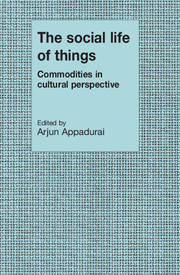Book contents
- Frontmatter
- Contents
- Contributors
- Foreword
- Preface
- Part I Toward an anthropology of thing
- Part II Exchange, consumption, and display
- Part III Prestige, commemoration, and value
- Part IV Production regimes and the sociology of demand
- 7 Weavers and dealers: the authenticity of an oriental carpet
- 8 Qat: changes in the production and consumption of a quasilegal commodity in northeast Africa
- Part V Historical transformations and commodity codes
- Index
7 - Weavers and dealers: the authenticity of an oriental carpet
Published online by Cambridge University Press: 05 June 2014
- Frontmatter
- Contents
- Contributors
- Foreword
- Preface
- Part I Toward an anthropology of thing
- Part II Exchange, consumption, and display
- Part III Prestige, commemoration, and value
- Part IV Production regimes and the sociology of demand
- 7 Weavers and dealers: the authenticity of an oriental carpet
- 8 Qat: changes in the production and consumption of a quasilegal commodity in northeast Africa
- Part V Historical transformations and commodity codes
- Index
Summary
The Orient is an integral part of European material civilisation and culture. Edward Said, Orientalism
Carpets, oriental
Oriental carpets have been recognized as prestigious furnishing in the West since the Middle Ages. In many ways, they represent the epitome of Western concern with alien things – especially utilitarian alien things. Carpets entered the Western cultural arena as a rare alien item of interest and eventually became a commodity. But commoditization does not adequately explain their continuing success in the market or the special attention they receive from collectors.
Why should this Western concern with the Other be epitomized in the Oriental Carpet? More significantly why should oriental carpets still. generate increasing demand, become ever more rather than less available, be stocked in a wider range of shops, and deployed in a steadily wider range of homes? The expansion apparently continues despite the changes in product and supply that result from accelerating social change and political disruption in the countries where they are produced. Oriental carpets are now bought and sold at a number of different levels of the market, from discount department stores to exclusive dealers available by appointment only. Objectively, they may be new or old (not “second-hand”), large or small. There is a wide range of price, durability, materials, designs, colors; the dyes may be natural or chemical. They may be purchased as floor covering, for decor, or as a collector's item.
- Type
- Chapter
- Information
- The Social Life of ThingsCommodities in Cultural Perspective, pp. 195 - 235Publisher: Cambridge University PressPrint publication year: 1986
- 102
- Cited by

